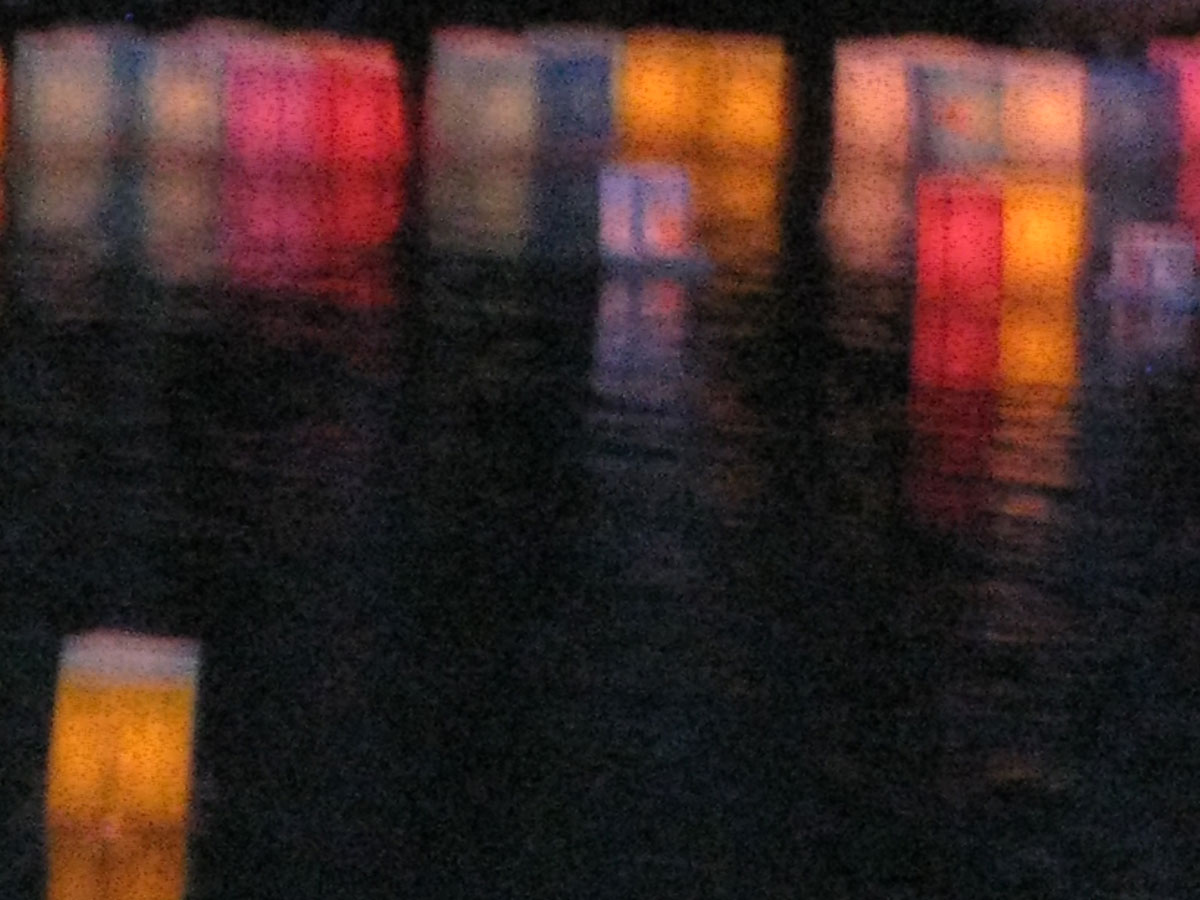
August 6, 2011
Our last night, Brandon’s birthday and the 66th anniversary of the bomb. We are sitting by the Ota river, legs dangling over the slanted rock wall. Hundreds of paper lanterns float past—red, bright pink, blue, aqua, white, yellow—along with some homemade ones. People write names, mostly family who’ve passed in the war, with prayers of peace. A few words go water born, the feeling more reminiscent of floating on air than water. It reminds me: the schoolhood ritual of releasing balloons (before the environmental factors were known, fish stomachs clogged with latex. And back then, not having any understanding—what were we partaking in, what was the ritual? It escapes me now if it ever captivated to begin. Tonight, the cicadas are behind us, the static of the band playing from across the river music for the hibakusha, music for the dead, music for foreign onlookers. The water infused. What we’ve let go goes, down river, the souls we remember but can no longer hold onto. Awaywards! Our respect given. It is getting darker. I am only just beginning to see the faint glow as the paper lanterns pass underneath the bridge of the candle placed within. The lanterns caught against the side wall, huddling together in a dark half cave, until a single strand of current unravels them, yanked back into motion for a moment the contours of the lantern disappears the light seems like only a reflection cast on the water.
August 2, 2011
Went to the A-Bomb Museum and Peace Park—our first full day in Hiroshima. The grounds where it’s all located—Dome, Library, Museum, Park, Memorials, Mass grave/crematorium—is like a community center, people visiting and gathering in the different buildings and rooms of the centers, sitting in the grass, relaxing alongside tourists snapping photos—it feels like an integrated part of the city rather than a single destination. The site creating community in addition to invoking horror, leaving people only to feel depressed, angry. It is, after all, the Peace Park. Brandon and I, among the community—the immediate one of Hiroshima and the one at large—were silent. Floating from one plaque to the next. I didn’t feel my feet touch the ground. Present among the unfathomable. No matter how grounding each site, it was unfathomable. The images belong to history which we then had to find our own ways of seeing. Not even the most concrete vestige from that day—the Dome—could locate me, or itself, back during that time. The Dome morphed by louder, newer buildings. The Dome with its holes, life and a thriving city shown through, the Dome: “look only.” The Dome, my eyes walking circles around it, counting its windows as if to have some inarguable recognition of its worth—even if numerical, even if a number was inaccurate but symbolizing only my need to document, stiffly, some factual characteristic of its being. How else to describe it but by my own failure to comprehend it? Easier to hold a number in one’s mind than to feel the image, the immediate that is actually given—the image—is case and study. The image, watery as it becomes the moment one blinks. Glassless windows, open graves. The moment one blinks and lets go. Is left only to their impressions. And what are my impressions? One survey near the museum wanted to know. It would have been less horrific if I had used emoticons than to write what it was I wrote! And every 30th step or so, trying to imagine the importance of all this in Brandon’s work. How important his work is to me. How all of this makes writing appear on a page, like a blast burn. The shadow of grass on cement. It is equally unfathomable. How to be in the unfathomable? Is it to try and make it all more fathomable? The relics and numbers and burnt clothes and melted bottles, pictures of that cloud, black rain on a white wall—is it to make it more real? To bring the day to its present standstill? To acknowledge what still exists was saved?
How can anything be more real than the unfathomable? Why get too close to something as if it take it out of its history? History is real and reeling. The motto here: “never forget.” Giving it this specific goal makes me at once skeptical it can ever be achieved or its achievement is sufficient. I can “imagine” the bomb—taking the various images into the mind’s eye (the flash, the river of bodies) but it becomes unimaginable once I apply the image in my head to an actual place, remove the imagination from the image, to actual people who survived, actual scars from the actual horror of our world’s mind. We are still in the age of the A-bomb. Our thinking is of nuclear warfare. I can’t paint over the present with the present.
I’ve come here and failed. I thought I would find out more about the bomb. But I don’t “see” the bomb here. In ways I need to learn where the bomb is now. In our daily politics, in our consciousness, as it exists without a proper location. I need to know I’m meeting it most days without realizing it, looking at it in the eyes and calling it something else.